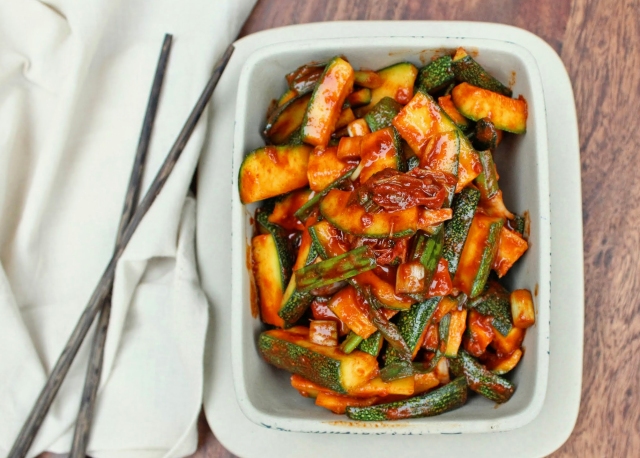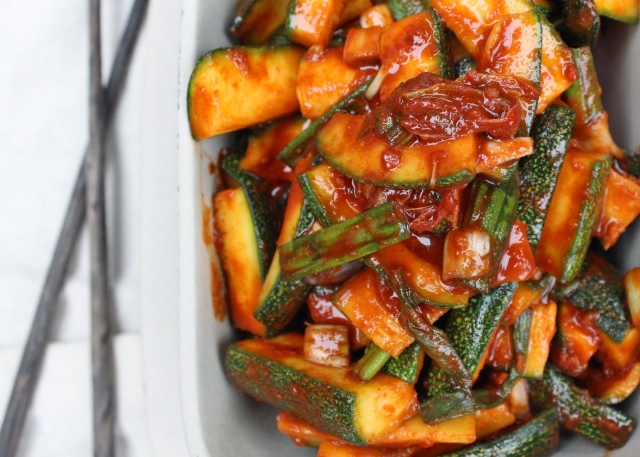A lot of Chinese restaurants in India serve Kimchi as a condiment. That tastes like Indian pickle. Tossed with chilli powder and salt (and sometimes spices. eek). Having said that though, I do always end up mindlessly munching my way down half a bowl of the stuff whilst contemplating what to eat. I mean, it’s not bad, but it’s not what they say it is.
I don’t claim my version here to be completely authentic by any means, but I have tried to get my hands on the ingredients that are traditionally used. It doesn’t help that I’m often chasing after recipes that call for some exotic elements that I will never be able to get my hands on where I live (I think it’s only right that my father-in-law deserves some credit here for lugging food stuff for me every time he travels abroad). I ask for two small tubes of Harissa paste – I get four large ones. Two rolls of cling film? Enough to last Dexter through seasons 1 – 8. True story.
Kimchi is Korea’s national dish. It is a fermented vegetable condiment – mainly using Napa cabbage – combined with a variety of seasonings such as Gochugaru, or Korean red pepper powder, garlic, ginger etc., There are over a thousand varieties of Kimchi in Korea, and they are categorized in terms of geographical locations, seasons, and temperature differences. For example, the Kimchi found in the Northern parts of Korea tends to have less salt and spice, and is way more watery in consistency.
Making Kimchi follows the science (and art, I’m told) of lacto-fermentation, whereby the zucchini is first tossed in coarse salt for 1 – 2 hours to kill any harmful bacteria, before it is combined with the seasonings. For the uninitiated, this may sound like some major scientific procedure, but I assure you that it’s no more than some chopping and rinsing action.
While purists claim that traditional Kimchi must include some sort of a seafood element – like shrimp paste or fish sauce – others completely frown upon the idea. Some have daikon radishes and carrots in their mix, while others don’t. The truth is, there is no one way of making Kimchi. There is only your way. Taste as you go as the seasonings are quite potent (esp the Gochujang paste – love this stuff), but other than that, you’re good to follow your own adventure. More than the sum of its parts, this simple Kimchi is both unusual and delicious!
INGREDIENTS : (Makes 3 cups)
Adapted from David Lebovitz and thekitchn
2 large zucchinis, cut lengthwise into 3” batons
2 stems of spring onions, cut into 2” batons
3 large garlic cloves, minced
1” piece of ginger, minced
1 tbsp fish sauce
2 tbsp Korean Gochujang paste
1 tsp Gochugaru (chilli powder is a good substitute)
¼ cup white rice vinegar
½ tsp sugar
3 tbsp coarse salt
METHOD:
Toss the zucchini slices in 3 tablespoons of coarse salt, combine well, and set aside for 1 – 2 hours. Tip out the slices and the salty juices that will have collected into a colander and rinse thoroughly. Taste a piece and make sure it’s not too salty. If it is, rinse until it tastes right to you.
In another bowl, mix together the minced garlic, ginger, fish sauce, Gochujang paste, chilli powder, sugar, and rice vinegar.
Add the zucchini in handfuls to the marinade mixture, making sure to squeeze out the excess liquid before each addition. Toss in the spring onions.
Store in an air-tight glass jar and let stand in room temperature for 2 – 3 days. Shake the jar every day to make sure they are completely submerged in the briny liquids. When the Kimchi tastes pickled enough for your liking, refrigerate for 1 day before serving.






Leave a Reply